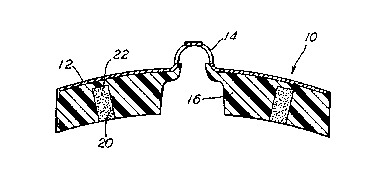Une partie des informations de ce site Web a été fournie par des sources externes. Le gouvernement du Canada n'assume aucune responsabilité concernant la précision, l'actualité ou la fiabilité des informations fournies par les sources externes. Les utilisateurs qui désirent employer cette information devraient consulter directement la source des informations. Le contenu fourni par les sources externes n'est pas assujetti aux exigences sur les langues officielles, la protection des renseignements personnels et l'accessibilité.
L'apparition de différences dans le texte et l'image des Revendications et de l'Abrégé dépend du moment auquel le document est publié. Les textes des Revendications et de l'Abrégé sont affichés :
| (12) Brevet: | (11) CA 2141720 |
|---|---|
| (54) Titre français: | SEMELLE DE FREIN SERVANT AU REPROFILAGE A LA SURFACE DE ROULEMENT DE ROUES |
| (54) Titre anglais: | WHEEL TREAD CONDITIONING BRAKE SHOE |
| Statut: | Périmé et au-delà du délai pour l’annulation |
| (51) Classification internationale des brevets (CIB): |
|
|---|---|
| (72) Inventeurs : |
|
| (73) Titulaires : |
|
| (71) Demandeurs : |
|
| (74) Agent: | MACRAE & CO. |
| (74) Co-agent: | |
| (45) Délivré: | 1999-08-31 |
| (22) Date de dépôt: | 1995-02-02 |
| (41) Mise à la disponibilité du public: | 1996-07-11 |
| Requête d'examen: | 1995-02-02 |
| Licence disponible: | S.O. |
| Cédé au domaine public: | S.O. |
| (25) Langue des documents déposés: | Anglais |
| Traité de coopération en matière de brevets (PCT): | Non |
|---|
| (30) Données de priorité de la demande: | ||||||
|---|---|---|---|---|---|---|
|
A brake shoe for engagement with the tread of a
railway car wheel having a tread conditioning agent
incorporated in the composition friction brake shoe
material of the brake shoe block for altering the adhesion
between the wheel and rail on which the railway car is
guidably supported. The tread conditioning agent is a
material that is dissimilar from the composition friction
material of the brake shoe block, being chosen in
accordance with a lubricating quality or an abrasive
quality depending upon whether the brake shoe use is
intended to reduce or increase wheel/rail adhesion. In
either case, the chosen conditioning material has a wear
rate that exceeds that of the composition friction material
so that the degree of conditioning is controlled by the
wear rate of the composition friction material and the
percentage of brake surface of the brake shoe block
occupied by the conditioning material.
Note : Les revendications sont présentées dans la langue officielle dans laquelle elles ont été soumises.
Note : Les descriptions sont présentées dans la langue officielle dans laquelle elles ont été soumises.

2024-08-01 : Dans le cadre de la transition vers les Brevets de nouvelle génération (BNG), la base de données sur les brevets canadiens (BDBC) contient désormais un Historique d'événement plus détaillé, qui reproduit le Journal des événements de notre nouvelle solution interne.
Veuillez noter que les événements débutant par « Inactive : » se réfèrent à des événements qui ne sont plus utilisés dans notre nouvelle solution interne.
Pour une meilleure compréhension de l'état de la demande ou brevet qui figure sur cette page, la rubrique Mise en garde , et les descriptions de Brevet , Historique d'événement , Taxes périodiques et Historique des paiements devraient être consultées.
| Description | Date |
|---|---|
| Inactive : CIB de MCD | 2006-03-11 |
| Inactive : CIB de MCD | 2006-03-11 |
| Inactive : CIB de MCD | 2006-03-11 |
| Le délai pour l'annulation est expiré | 2006-02-02 |
| Lettre envoyée | 2005-02-02 |
| Lettre envoyée | 2003-02-25 |
| Accordé par délivrance | 1999-08-31 |
| Inactive : Page couverture publiée | 1999-08-30 |
| Inactive : Taxe finale reçue | 1999-05-20 |
| Préoctroi | 1999-05-20 |
| Un avis d'acceptation est envoyé | 1998-12-16 |
| Lettre envoyée | 1998-12-16 |
| Un avis d'acceptation est envoyé | 1998-12-16 |
| Inactive : Renseign. sur l'état - Complets dès date d'ent. journ. | 1998-12-07 |
| Inactive : Dem. traitée sur TS dès date d'ent. journal | 1998-12-07 |
| Inactive : Approuvée aux fins d'acceptation (AFA) | 1998-11-04 |
| Demande publiée (accessible au public) | 1996-07-11 |
| Toutes les exigences pour l'examen - jugée conforme | 1995-02-02 |
| Exigences pour une requête d'examen - jugée conforme | 1995-02-02 |
Il n'y a pas d'historique d'abandonnement
Le dernier paiement a été reçu le 1999-01-27
Avis : Si le paiement en totalité n'a pas été reçu au plus tard à la date indiquée, une taxe supplémentaire peut être imposée, soit une des taxes suivantes :
Veuillez vous référer à la page web des taxes sur les brevets de l'OPIC pour voir tous les montants actuels des taxes.
| Type de taxes | Anniversaire | Échéance | Date payée |
|---|---|---|---|
| TM (demande, 3e anniv.) - générale | 03 | 1998-02-02 | 1998-01-21 |
| TM (demande, 4e anniv.) - générale | 04 | 1999-02-02 | 1999-01-27 |
| Taxe finale - générale | 1999-05-20 | ||
| TM (brevet, 5e anniv.) - générale | 2000-02-02 | 2000-01-20 | |
| TM (brevet, 6e anniv.) - générale | 2001-02-02 | 2001-01-18 | |
| TM (brevet, 7e anniv.) - générale | 2002-02-04 | 2002-01-18 | |
| TM (brevet, 8e anniv.) - générale | 2003-02-03 | 2003-02-03 | |
| TM (brevet, 9e anniv.) - générale | 2004-02-02 | 2003-02-03 |
Les titulaires actuels et antérieures au dossier sont affichés en ordre alphabétique.
| Titulaires actuels au dossier |
|---|
| WESTINGHOUSE AIR BRAKE COMPANY |
| Titulaires antérieures au dossier |
|---|
| BRUCE W. SHUTE |
| JOSEPH F. FORMOLO |